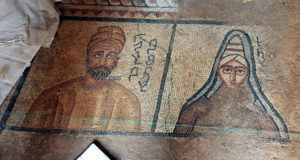Mosaics Discovered of “Christian king” Abgar
 According to the Daily Sabbah, five mosaics have been discovered from the reign of Abgar V (r. 4 BCE – 7 CE; 13-50 CE), the fifth king of the kingdom of Osroene (Edessa), “depicting fine engravings and Syriac inscriptions.” The find is pertinent to scholars of Christian Apocrypha because Abgar is featured in a famous correspondence with Jesus. This correspondence is known to Eusebius, who translates it from Syriac in his Ecclesiastical History (I 13; II 1.6-8). Ephrem Syrus (d. 373) also mentions the conversion of Edessa but not the correspondence, and Egeria the Pilgrim visited Edessa in 384 admired the palace of Abgar and was told about the letters by the bishop of Edessa. The correspondence was widely copied throughout the East and the West, both in manuscript form and in inscriptions, and appears also in expanded form in the Doctrine of Addai.
According to the Daily Sabbah, five mosaics have been discovered from the reign of Abgar V (r. 4 BCE – 7 CE; 13-50 CE), the fifth king of the kingdom of Osroene (Edessa), “depicting fine engravings and Syriac inscriptions.” The find is pertinent to scholars of Christian Apocrypha because Abgar is featured in a famous correspondence with Jesus. This correspondence is known to Eusebius, who translates it from Syriac in his Ecclesiastical History (I 13; II 1.6-8). Ephrem Syrus (d. 373) also mentions the conversion of Edessa but not the correspondence, and Egeria the Pilgrim visited Edessa in 384 admired the palace of Abgar and was told about the letters by the bishop of Edessa. The correspondence was widely copied throughout the East and the West, both in manuscript form and in inscriptions, and appears also in expanded form in the Doctrine of Addai.
This is Eusebius’s version of the correspondence (from M. R. James, The Apocryphal New Testament):
A copy of a letter written by Abgarus the toparch to Jesus, and sent to him by means of Ananias the runner, to Jerusalem.
Abgarus Uchama the toparch to Jesus the good Saviour that hath appeared in the parts (place) of Jerusalem, greeting. I have heard concerning thee and thy cures, that they are done of thee without drugs or herbs: for, as the report goes, thou makest blind men to see again, lame to walk, and cleansest lepers, and castest out unclean spirits and devils, and those that are afflicted with long sickness thou healest, and raisest the dead.
And having heard all this of thee, I had determined one of two things, either that thou art God come down from heaven, and so doest these things or art a Son of God that doest these things.
Therefore now have I written and entreated thee to trouble thyself to come to me and heal the affliction which I have. or indeed I have heard that the Jews even murmur against thee and wish to do thee hurt. And I have a very little city but (and) comely (reverend), which is sufficient for us both.
The answer, written by Jesus, sent by Ananias the runner to Abgarus the toparch.
Blessed art thou that hast believed in me, not having seen me.
For it is written concerning me that they that have seen me shall not believe in me, and that they that have not seen me shall believe and live. But concerning that which thou hast written to me, to come unto thee; it must needs be that I fulfil all things for the which I was sent here, and after fulfilling them should then be taken up unto him that sent me.
And when I am taken up, I will send thee one of my disciples, to heal thine affliction and give life to thee and them that are with thee.
The Daily Sabah article goes on to say, “It is believed that Abgar V was one of the first Christian kings in history, having been converted to the faith by the Apostle Thaddeus of Edessa, one of the Seventy-two Disciples sent out to spread Christianity.” However, scholars are in general agreement that Abgar’s conversion is a fiction, one created by the church in the early fourth century to establish early proto-orthodox presence in the East (for more on this argument, see ch. 1 of Walter Bauer’s Orthodoxy and Heresy in Earliest Christianity; or H. J. W. Drijver’s entry on “The Abgar Legend” in Schneemelcher, New Testament Apocrypha, vol. 1, pp. 492-500). Evidence suggests that the earliest forms of Christianity in the Syriac-speaking world were somewhat unorthodox: Bar Daisan, the “school of Thomas,” Marcionism, and Manichaeism all preceded proto-orthodoxy. Furthermore, the monarchy in Edessa seem to have been polythesists long into the fourth century.
The discovery of these mosaics is indeed an important discovery, but readers should be cautioned that Abgar V’s conversion is an extremely unlikely event. But it is interesting that knowledge of this conversion originated in an apocryphal tale, albeit one preserved by an orthodox writer.

Dorothy Lobel King sent me a link to a list (with images) of Syriac mosaics that have been looted. You can see it here: http://lootbusters.blogspot.ca/2016/10/edessa-mosaics-with-syriac-inscriptions.html. If you find any of them, Turkey would like them back!